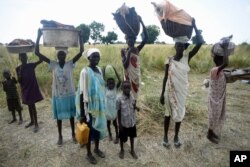United Nations aid agencies say the conflict in South Sudan, combined with recent weather patterns, have further reduced crop production in the country.
The U.N.’s Food and Agricultural Organization and World Food Program say South Sudan’s cereal production is down by 400,000 metric tons this year, a drop of 53 percent compared to last year.
The situation has aggravated the already severe food shortages across the country.
These estimates follow reports from other aid groups that most families are surviving on only one meal a day because of skyrocketing food prices.
Bernard Owadi, head of the WFP Food Security and Vulnerability Analysis in South Sudan, said the situation is expected to get worse. Food prices are four or five times what they were just a few months ago, according to Owadi.
Traders are not able to import as many commodities as before, because they face far more difficulties in transporting food along the main roads.
“What is significant at this point in time is that due to the depreciation of the local currency, due to the economic downturn, the imports are no longer able to meet that gap," he says.
Seeds, tools needed
The agencies’ estimates stem from a joint crop and food assessment report conducted across the country from November 30 to December 18, 2015.
Mario Zappacosta, an economist with the FAO’s Global Information and Early Warning System Trade and Markets Division in South Sudan, said there are two major reasons for the steep drop in food production.
“The 2015 cropping system was affected by let’s say two factors; in some areas by the unfavorable weather and in some areas by the conflict.”
Former states like Western Equatoria were once referred to as “The food basket of South Sudan.” That’s no longer the case, due in large part to ongoing fighting between government forces and so-called “Arrow Boys,” local, armed vigilantes who have rebelled against the government.
Zappacosta said food insecurity is worsening across the entire country -- not only in the most conflict-prone areas of Upper Nile state but also in places like northern Bar El Ghazal and Lakes states.
U.N. agencies are calling for immediate action to address the hunger and strengthen domestic food production.
Zappacosta says if seeds and tools are provided, the communities are able to produce their own food and withstand market disruptions. “Both the international community and the local institutions should try to improve the food security situation in the coming months," he says.
In February, the FAO, WFP and U.N. Children's Fund warned that South Sudan was facing unprecedented levels of food insecurity, adding that 2.8 million people, about a quarter of the population, remain in urgent need of food assistance.
The U.N. agencies said at least 40,000 people in South Sudan are on the brink of catastrophe.






